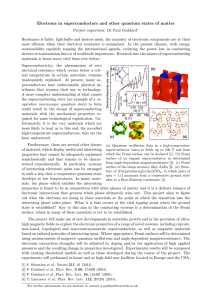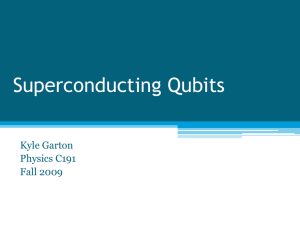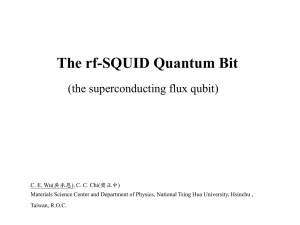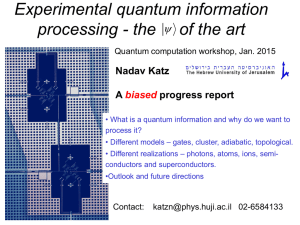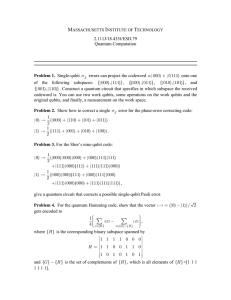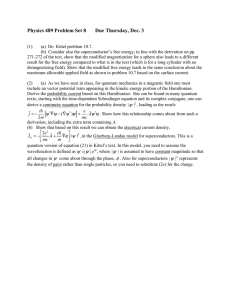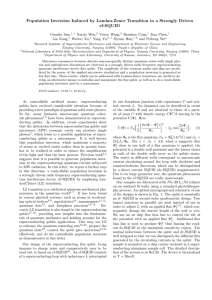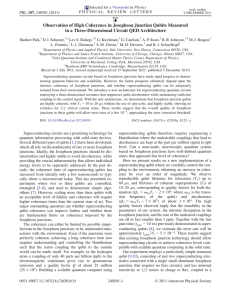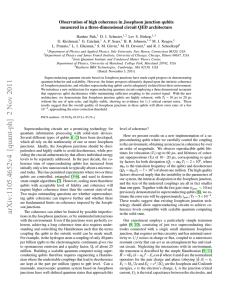Josephson Junction Qubits: Superconducting Quantum Computing
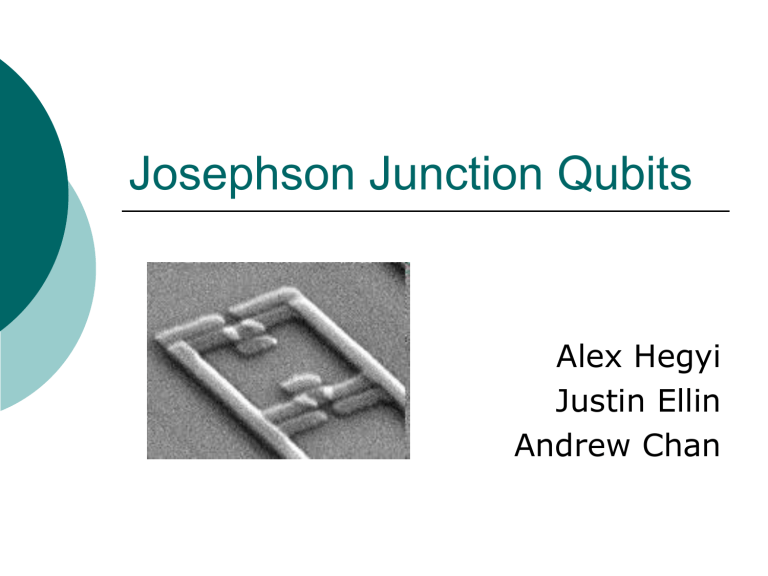
Josephson Junction Qubits
Alex Hegyi
Justin Ellin
Andrew Chan
Classical Resistance (Review)
Metals
In a metal, the electrons are shared by atoms in a lattice.
This sea of electrons is free to travel along the entire lattice.
Dissipation
Caused by inter-electron/ion interactions or other atoms, resulting in heat
(dV) = (dI)R, R = pL/A (p resistivity, length, cross-sectional area)
P = IV
Prevents indefinite propagation of currents, analogous to friction
Superconductors
Superconductor Properties
State characterized by zero (exactly) electrical resistance
Meissner Effect – weak external fields only penetrate small distances (London skin Depth)
Type I – Superconductivity destroyed abruptly when field reaches critical value
Type II – additional critical temperature which permits magnetic flux but still no electrical resistivity
Generation of a current to cancel external field
BSC Theory
Fermi Energy
The lowest energy of the highest occupied quantum state at absolute zero was considered to be the Fermi Energy
Where N/V is the density of fermions
This can be derived by considering a 3-dimensional square box.
BSC- Bardeen, Cooper, and Schrieffer 1957
The theory essentially accounts for an energy level even below this threshold.
The gap between this energy level and the fermi energy accounts for many of the properties of superconductors
Whereas before the electron could be excited in a continuous spectrum of possible energy interactions (and interchange/lose energy with lattice and other electrons), there is now a discrete energy gap.
The excitations become forbidden and the electron sees no
“obstacles” or no resistance! But what accounts for this gap?
Cooper Pairs
The atoms in a lattice are not fixed
Free electrons are repulsed from other electrons but are able to attract and distort the positively charged nucleus. This distortion in turn attracts other electrons.
Coupling (on the order of fractions of an eV) usually broken by thermal energy or coulomb interaction.
When the thermal energy is low, T ~ 5K, this dominates effectively linking electrons in pairs to each other even over “large” distances .
The electrons pair up with those of opposite spin.
Exclusion principle no longer applies. All electron pairs condense into this bound state energy.
Two Notes on Modern Superconductors
Current Lifetime – occasionally interactions may result that do go across the gap.
Experimentally, currents on superconductors can perpetuate for upwards of tens of thousands of years.
Theoretically, could last longer than the known age of the universe.
High Temperature Superconductors –superconductors that can’t be explained by BCS because state achieved well above fermi levels
(Sn
5
In)Ba
4
Ca
2
Cu
10
O y
: superconducting at ~200K (Dry ice is about this range)
How do they work?
Josephson Junction
Brian David Josephson proposed (1964) sandwiching an insulator between two superconductors.
Provided separation is small, current will tunnel through the barrier
However when the current reaches a certain critical value then a voltage will develop across the junction which will in turn increase the voltage further.
The frequency of this oscillation is ~ 100 GHz
Below this critical current, no voltage. Above, oscillating voltage.
Some Uses of Junctions
SQUIDs (superconducting quantum interference devices)
Precise Measurements
Voltage to Frequency Converter
Single-Electron Transistors
Flux Qubit
Quantum state is stored in the direction of the current
|0> is counter-clockwise
|1> is clockwise
Manipulate State
Requires a constant external magnetic flux
Flux determines the energy difference between the two states
Apply a microwave pulse
Causes the flux qubit to oscillate between ground state (|0>) and excited state (|1>)
SQUID
Superconducting Quantum
Interference Device
Critical Current
Below:
Current flows without voltage
Above:
Oscillating current develops
Measurement
Apply a current pulse to SQUID
Collapses state
Magnetic flux through flux qubit determines critical current of SQUID
Qubit Interaction
Entanglement between two qubits is achieved by coupling their fluxes
Superconducting bus
Transfers a quantum state from one qubit to another by sending a single photon along a superconducting wire
“Additional” DiVincenzo Criteria
Conversion of stationary, flying qubits
Optical Microcavities, Cavity QED
Transmission of flying qubits
Fiber Optics
Microwave transmission lines
(Circuit QED)—way to accomplish the above in case of superconducting qubits *
*Wallraff et al., Nature, 431, 9 Sept. 2004
Strong Coupling/Cavity QED
Two-level quantum system coupled to electromagnetic cavity
“Strong Coupling” characterized as coherent exchange of excitation between cavity, quantum system
i.e., coherent conversion between stationary, flying qubit
Model—Two SHOs connected by weak spring
Microwave Resonator/Qubit System
*Schoelkopf and Girvin,
Nature, 451, 7 Feb. 2008
Quantum Communication
If energy difference between |0> and |1> resonant with cavity, energy exchanged (Rabi rotation)
If off-resonant (dispersive) energy not exchanged
Align qubits along transmission line, tune energy difference (using gate bias, flux bias) to control interaction with line
Microwave Resonator/Qubit System
*Wallraff et al., Nature, 431, 9 Sept. 2004
